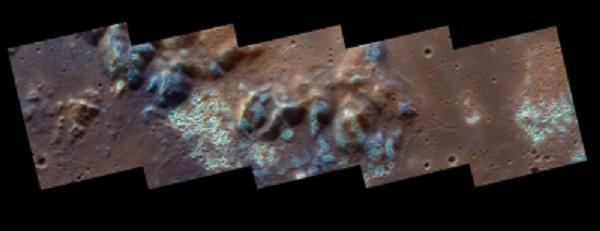[/caption]
How long has it been since you’ve taken a good look at Mercury? For the backyard astronomer, all we’ll ever see is the speedy little planet as a bright crescent a few times a year. But, for the MESSENGER spacecraft, Mercury isn’t quite as boring as you might think! Some strange new features have been spotted and a planetary geologist speculates they could be attributed to hydrogen venting from the planet’s interior.
While it’s only been a week since MESSENGER sent back some curious photos of Mercury’s surface, the revelation has created quite a stir in the planetary science community. These observations have included evidence of shallow depressions which have formed into non-uniform crater structures which appear to be recent. In addition, they have a high albedo – indicative of some sort of reflective material. But, what?
According to Marvin Herndon, an independent scientist based in San Diego, Mercury formed under great pressure and high temperature – enough to leave iron in a molten state. If so, it should be responsible for absorbing large amounts of hydrogen. As it cools and transforms to a solid state, the hydrogen is then released, forming a type of “geyser” on the planet’s surface.
“These hydrogen geysers could certainly have caused the rimless depressions that MESSENGER sees.” says Herndon, a self-proclaimed maverick in the world of planetary geology.
As the hydrogen is released from below the planet’s surface, it would also react with other elements it would encounter – possibly iron sulphide, commonly found on Mercury’s surface. This would cause a reduction to metallic iron. From there it would form a light “dust” which could account for the bright, new features seen by MESSENGER.
Original Story Source: MIT Technology Review News Release. For Further Reading: Explanation for Observed Evidence of Geologically Recent Volatile-Related Activity on Mercury’s Surface.


Interesting concept!
Hydrogen production on Mercury is VERY interesting…. as is the possibility of Methane production within the Earth’s crust.. which could re-write theories of planetary evolution. So this is a VERY interesting development! and is another fine reason to continue our exploration of the solar system…. Live and Learn!
There are many potential pathways to methane within our crust: kerogens preferentially loosing oxygen first (natural gas), methanogens, serpentinization and Fischer-Tropsch reactions at hot zones. Most or all validated.
All of them are consistent with today’s models of planetary evolution AFAIK. So what are your idea here?
May be the terrestial planets form from the inside out, and Mercury is the youngest one… At least the one with the most liquid core. I wonder what will be found next (for example a very strong alternating magnetic field) – interesting mission!
a very good example of the need to have a ‘solid foundation’ in the ‘understanding’ of chemistry.
I got a glimps of Mercury last evening, about 30 minutes after sunset. It’s below Venus, and just a bit to the left. I could only see it through binoculars though.
I’ll pitch in with zetetic elench here, or at least it is my interpretation of what he/she said. Hydrogen venting would be a possibility, since I hear the new data points to Mercury as the most reduced terrestrial.
But as for placing it with iron and having sulfides outside a pure core seems to invert the differentiation believed to be in place on Earth (with an iron-nickel sulfurous core). It is the sulfur lowering of the iron melt temperature (IIRC) that decides this in the first place.
This is ATM nonsense. The proponent of this idea is a crackpot who thinks that the Earth was 64% smaller in the past than today, that plate tectonics is the result of “planetary decompression”, that the earth’s magnetic field is created by a nuclear fission reaction in the earth’s core, and numerous other crazy ideas (look for his website).
Why is UT publishing this garbage?
This is ATM nonsense. The proponent of this idea is a crackpot who thinks that the Earth was 64% smaller in the past than today, that plate tectonics is the result of “planetary decompression”, that the earth’s magnetic field is created by a nuclear fission reaction in the earth’s core, and numerous other crazy ideas (look for his website).
Why is UT publishing this garbage?
This is ATM nonsense. The proponent of this idea is a crackpot who thinks that the Earth was 64% smaller in the past than today, that plate tectonics is the result of “planetary decompression”, that the earth’s magnetic field is created by a nuclear fission reaction in the earth’s core, and numerous other crazy ideas (look for his website).
Why is UT publishing this garbage?